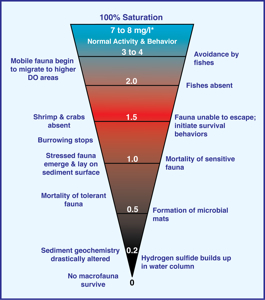VIMS issues annual dead-zone report card for the Chesapeake Bay
Sharp drop in mid-summer hypoxia shows importance of wind mixing
An annual model-based report on “dead-zone” conditions in the Chesapeake Bay during 2018 indicates that the total volume of low-oxygen, “hypoxic” waters was very similar to the previous year, but a sharp drop in hypoxia during late July shows the critical role of wind mixing in short-term variations in the oxygen content of Bay waters. The duration of hypoxia in 2018 was greater than in recent years.
 Dead zones are one of the major water-quality concerns facing the Bay. They form when rivers carry in excess nitrogen from fertilizers, wastewater, and other sources, fueling short-lived blooms of algae. Bacteria then eat the dead, sinking algae, consuming from bottom waters the dissolved oxygen that fish, shellfish, crabs, and other animals need to survive. Bay dead zones peak during summer, when hot weather encourages algal growth and drives gases from the water, while calm winds typically preclude the mixing of relatively oxygen-rich surface waters into the depths.
Dead zones are one of the major water-quality concerns facing the Bay. They form when rivers carry in excess nitrogen from fertilizers, wastewater, and other sources, fueling short-lived blooms of algae. Bacteria then eat the dead, sinking algae, consuming from bottom waters the dissolved oxygen that fish, shellfish, crabs, and other animals need to survive. Bay dead zones peak during summer, when hot weather encourages algal growth and drives gases from the water, while calm winds typically preclude the mixing of relatively oxygen-rich surface waters into the depths.
The Annual Chesapeake Bay Hypoxia Report Card is the brainchild of Dr. Marjy Friedrichs of the Virginia Institute of Marine Science and Dr. Aaron Bever of Anchor QEA, an environmental and engineering consulting firm. Bever earned his Ph.D. from William & Mary’s School of Marine Science at VIMS in 2010.
The team’s report card summarizes oxygen conditions in the Bay each year as estimated by their 3-D, real-time hypoxia forecast model, originally developed with funding from NOAA. The model is based on 30 years of water quality data collected by the Chesapeake Bay Program, and is forced daily by wind data provided by NOAA and river-input data provided by the U.S. Geological Survey. The modeling team, which includes Dr. Raleigh Hood of the University of Maryland Center for Environmental Science, also generates dissolved oxygen statistics for previous years for comparative purposes.
Because springtime inflows from the Susquehanna River were high in 2018, scientists predicted that summer 2018 would have an above average amount of hypoxia, a forecast that held true through mid-July, when unusually strong winds reduced the Bay’s hypoxic volume to near zero. Hypoxia increased rapidly again in early August and peaked at a higher value in early September than in previous years. Strong winds in September again mixed Bay waters, resulting in a large reduction in hypoxic volume.

Says Bever, “The lack of hypoxia in late July was very atypical of historical dissolved oxygen conditions for mid-summer.” Friedrichs adds, “It’s fascinating how the hypoxic volume was so low in late July and so high in early September, but overall the hypoxic volume was basically the same as last year.”
“Overall,” she says, “our model indicates that the total amount of hypoxia in 2018 was similar to 2017, but that the seasonal patterns in hypoxia were very different. In addition to late-July’s major hypoxic dip, low-oxygen conditions started earlier and lasted longer in 2018 than in recent years.” Friedrichs notes that related research—by recent VIMS Ph.D. graduate Ike Irby—suggests that an earlier onset of spring hypoxia may be growing more common, as May temperatures increase due to climate change.

To put this year’s late-July “hypoxia hiatus” in perspective, Friedrichs notes that low-oxygen waters occupy on average about 7% of the Bay’s entire volume during summer, and about 20% of the volume of Maryland’s Chesapeake waters—where Bay hypoxia is most pronounced. This year, hypoxia occupied 14.4% of the Bay’s mainstem waters on July 5 (a volume of 9.9 cubic kilometers), but by July 26—just three weeks later—had fallen to only 0.14% of mainstem water, with a volume of only 0.1 km3.
The findings of the VIMS hypoxia model and report card generally match the monitoring-based report provided by the Maryland Department of Natural Resources for the Maryland portion of the Bay. Variations in results are partially due to different reporting periods, as the Virginia report includes results from the onset of hypoxia in spring to its cessation in the autumn, while Maryland’s DNR reports on Maryland conditions from June through September, the period that specifically relates to the EPA’s water-quality-criteria assessment for summer dissolved oxygen.

